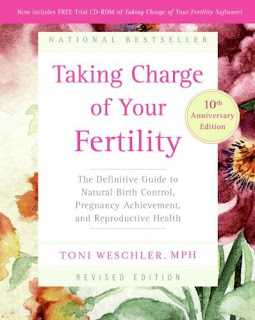We took a little while to get pregnant with our first baby so sex became a bit of a roller coaster for us. I finally decided to educate myself a bit more and read Taking Charge of Your Fertility
and I highly recommend it.
Here are some of the things I learned:
- Most (not all) women ovulate 14 days before their period. It's not after ending your period. Ovulation may vary month to month for the same woman.
- There are usually many variations in basal body temperature (BBT) throughout the month. A spike of about .4-.6 degrees usually signifies ovulation. Once your temperature has risen it means you have ovulated; it doesn’t mean that you’re about to ovulate. BBT varies between people. Take your temperature at the same time every day. Do it after having 5 hours of sleep so it’s a resting BBT. BBT is affected by stress, sickness etc.
- Your cervix changes position throughout your cycle. It can be low, raised, open, soft, hard etc. Generally a high, open, soft cervix is indicative that ovulation is about to occur.
- Your cervical mucus changes throughout your cycle. It can be sticky, thick, wet, flaky, dry, yellow, clear, opaque, nonexistent etc. Generally, mucus about the consistency of egg whites (thin, stretchy, clear) is indicative of ovulation. A woman’s fertile phase only lasts as long as she has fertile cervical mucus.
- Tracking BBT, cervical position and cervical mucus together can be the most helpful in determining ovulation.
- Sperm can survive in fertile (egg white consistency) cervical mucus for up to 5 days. This is longer than it will survive at any other time in your cycle.
- A woman’s egg can only live up to 24 hours.
- It’s okay to go to your doctor even if you have been trying to get pregnant for less than a year if you’ve been monitoring your body well (BBT, cervical mucus and cervical position) and have some knowledge of what’s going on. It will help the doctors have a better picture of what's going on. If you haven't been monitoring these, it's suggested that you wait until a year before seeking fertility help from a doctor.
- Conception actually occurs in the outer third of the fallopian tubes, not in the uterus. The sperm meets the egg in the fallopian tubes and they start to multiply into many cells and then go and implant on the uterine wall.
- Both men and women can have problems that cause infertility. About 1/3 of fertility problems are caused by women and another 1/3 by men and the other 1/3 are a combined reaction or unknown. Still, fertility should be thought of as a couple issue. Do not blame one of the partners!
Sex has the potential to become a bit stressful if you're taking a while to get pregnant, but remember that whether you make a baby that time or not to still enjoy the experience with your partner!


LOVE this book. I think EVERY WOMAN should read it. Even if they aren't trying to get pregnant. So good to know what your body is doing--no more surprises!
ReplyDeleteThat's a great book for ANY woman to read. When we were struggling through infertility I learned all kinds of stuff I wish I didn't need to know. Even so, I was always amazed when women who'd had several babies would say something that showed they really had no clue how the 'magic' happens. It's probably wise to be educated on the subject, whether or not you are infertile.
ReplyDeleteExcellent post. I was checking constantly this blog and I’m impressed! Very useful info specially the last part :) I care for such info much. I was seeking this certain information for a long time. Thank you and best of luck.
ReplyDeleteI also love this book, and I agree its a great book for any woman to read just for the information about her body and cycle!
ReplyDeleteThis article is very helpful. My friend is trying to get pregnant and this will definitely help her. Thanks for sharing.
ReplyDelete